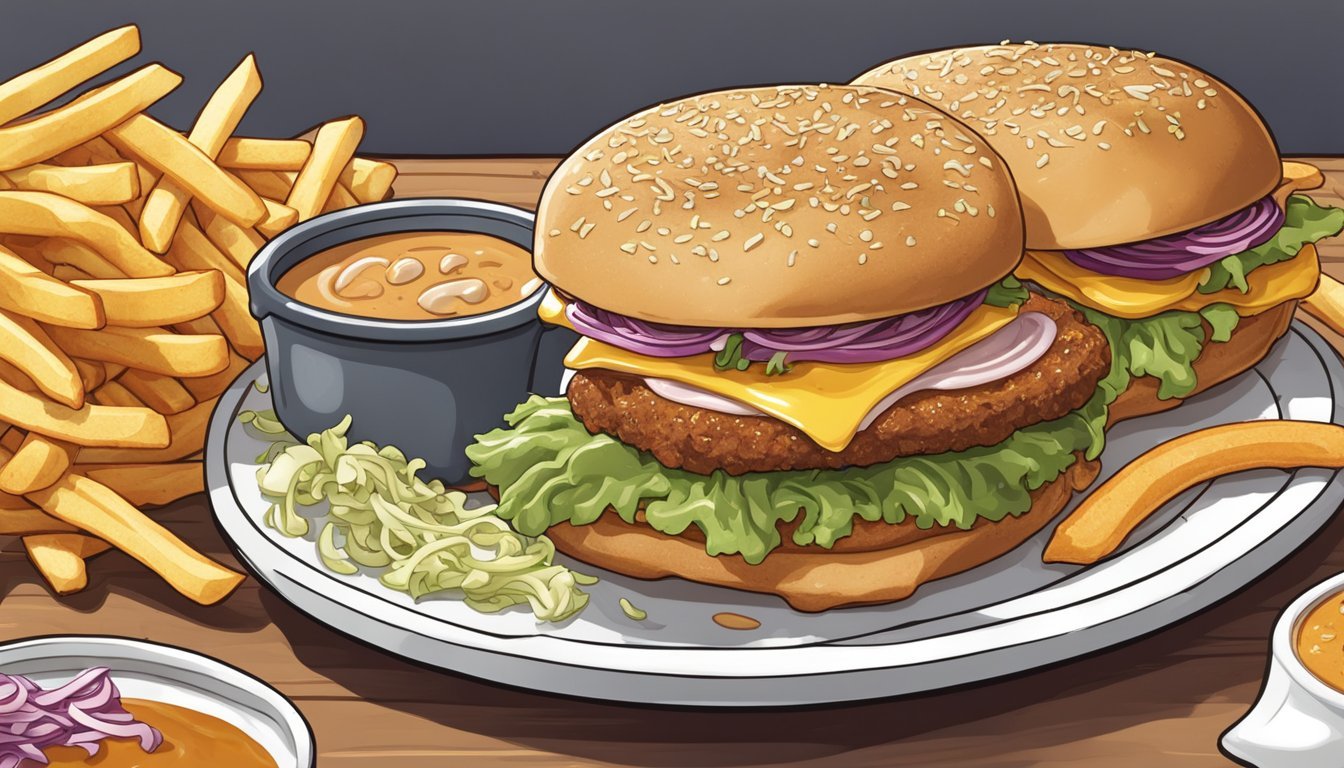Fried Brain Sandwiches Exploring a Unique Culinary Tradition of the Midwest
In the heartland of Midwest America, the fried brain sandwich stands as a testament to the region's culinary history. Often referenced in whispers or with a hint of nostalgia, this unique delicacy harks back to a time when the Midwest's bustling stockyards afforded an array of unconventional cuts of meat. Routinely, slices of calves' brains were breaded and fried to a golden crisp, nestled between slices of soft bread, and dressed with simple, robust condiments. At its height in popularity, the sandwich was a staple for the working class, a filling and inexpensive source of sustenance.
While the thought of consuming brains may seem peculiar to many, for generations of Midwesterners, it was a familiar and comforting fare. Originating from a period when frugality in the kitchen was paramount, chefs in the Midwest became adept at utilizing all parts of an animal. The brain, rich in texture and mild in flavor, lent itself well to frying and eventually became a sought-after ingredient for the hearty sandwich. This culinary creation was most prevalent in areas like St. Louis, where local eateries could readily access fresh offal from nearby stockyards.
Today, the dish is much rarer, a culinary relic that reflects changing tastes and a heightened awareness of food safety issues related to eating animal brains. Yet, despite its decline in popularity, the fried brain sandwich maintains a cult following. It serves as a reminder of the region's working-class roots, beckoning the curious and the culinarily adventurous to explore the complex tapestry of America's food heritage.
Historical Context of Fried Brain Sandwiches in the Midwest
Fried brain sandwiches (What wine goes well with sandwiches?) are a unique dish that has its roots deeply embedded in the cultural and economic history of the Midwest during the 20th century. This region-specific food reflects the resourcefulness and traditions of the American Midwest, particularly associated with the by-products of its bustling stockyards.
Origins and Midwest Tradition
The tradition of consuming fried brain sandwiches began in the Midwest with the rise of regional stockyards in the late 19th and early 20th centuries. As cities like St. Louis in Missouri grew into industrial hubs, they witnessed an increase in slaughtering operations, where all parts of an animal were utilized. This included the brains of cows and pigs, which were transformed into economical and nutritious meals for the working class.
St. Louis, Missouri: Known for widespread popularity of thinly sliced fried brain sandwiches on white toast.
Stockyards: Centers for processing that contributed off-cuts of meat, including brains destined for cooking.
Evansville's Culinary Contribution
Evansville, Indiana, has made a notable contribution to the legacy of the fried brain sandwich. Once considered the epicenter of this culinary tradition, Evansville patronized the dish, honoring the Midwest's historical inclination to use all parts of slaughtered livestock. This practice complemented the frugal ethos of the 20th-century American Midwest, where economical use of available resources was common.
Evansville's Specialty: A fried brain patty served on a bun, complemented by mustard, pickles, and raw onions.
What Are Fried Brain Sandwiches?
Fried brain sandwiches are a unique culinary offering in the Midwest United States. They consist of tender pieces of brain, usually pork or bovine, that are breaded and deep-fried to create a dish with a distinctive texture and flavor.
Examining the Ingredients
The primary ingredient in a fried brain sandwich is offal, specifically brains from a pig or cow. These are often soaked in a mixture of eggs and milk before being coated in flour or breadcrumbs. The combination of ingredients serves to enhance the brains' subtle taste and ensures the fried coating adheres properly for that satisfying crisp texture upon frying.
Key Ingredients:
Brain (pork or bovine)
Eggs
Milk
Flour or breadcrumbs
The Cooking Process
Proper cooking is critical when preparing a fried brain sandwich. The brains should be cleaned meticulously and sliced suitably thin before being dipped in the egg and milk mixture. This is followed by a coating in seasoned flour or breadcrumbs. They are then fried in oil at a controlled temperature—typically around 375°F (190°C)—until they achieve a golden brown and crispy appearance. The crispy exterior contrasts with the softness of the cooked brains, creating a textural balance that is key to the sandwich.
Steps for Frying:
Clean and slice brains thinly.
Soak in egg and milk mixture.
Coat with seasoned flour or breadcrumbs.
Fry until golden brown and crispy.
Nutritional Information
The nutritional profile of fried brain sandwiches encompasses various elements such as protein content, fats—particularly saturated fat—and cholesterol levels, common characteristics of off-cuts like animal brains.
Health Concerns
Animal brains are high in cholesterol and saturated fats. According to the USDA, a 3-ounce serving of beef brain contains approximately 1,033mg of cholesterol and 14g of saturated fat. High dietary intake of these nutrients can pose health concerns, particularly related to heart disease and stroke. Consumers should also be aware that the practice of eating animal brains carries a risk of transmission for certain diseases, such as Bovine Spongiform Encephalopathy (mad cow disease) when consuming bovine brains.
Balancing the Diet
Incorporating fried brain sandwiches into a balanced diet necessitates moderation and an awareness of daily nutritional needs. To offset the high levels of saturated fat and cholesterol found in fried brain sandwiches, they should be consumed occasionally rather than as a staple. Complementing them with a diet rich in vegetables, fruits, whole grains, and lean protein can help manage the overall intake of fats.
Nutrient: Cholesterol
Amount per 3-ounce serving: 1,033mg
% Daily Value: 344%
Nutrient: Saturated Fat
Amount per 3-ounce serving: 14g
% Daily Value: 70%
Nutrient: Protein
Amount per 3-ounce serving: 10g
% Daily Value: 20%
* Percent Daily Values are based on a 2,000 calorie diet. Your daily values may be higher or lower depending on your calorie needs.
Culinary Preparation and Variations
This section explores the traditional approaches and creative twists involved in preparing Fried Brain Sandwiches, from the choice of brains to the recommended side dishes.
From Pork to Bovine Brains
When making Fried Brain Sandwiches, the type of brain used can be from various animals, typically pork, calf, or lamb. Calf brains are a popular choice due to their milder taste and fine texture. Typically, the brains need to be cleaned thoroughly to remove any membrane or blood vessels. This process is crucial for achieving a pleasant texture and flavor in the finished product.
Seasoning and Flavor Enhancements
To elevate the flavor of the brains, a variety of seasonings and enhancements can be applied. Here is a table of common ingredients used:
Salt: Enhances the natural flavors
Garlic: Adds a robust taste
Fresh Herbs: Infuses the dish with aromatics
Black Pepper: Provides a spicy kick
Lemon Juice: Brightens the overall taste
The brains are often soaked in a seasoned mixture containing these elements before being coated in a batter or breadcrumb mixture.
Side Dishes and Complements
Fried Brain Sandwiches are traditionally served with a range of side dishes that complement their unique flavor. Popular choices include:
Onion Rings: Add a crispy and sweet flavor contrast.
Pickles: Offer a tangy counterpoint to the rich fried brain.
Mustard: Provides a sharp and pungent layer of flavor.
Pairing the sandwich with these sides not only balances the dish but also enhances the overall dining experience.
Serving and Presentation
When serving a fried brain sandwich, attention to bread choice and garnishes significantly enhances the dining experience.
Bun Choices and Toppings
Selecting the appropriate bun is crucial for a fried brain sandwich. Traditional options include:
Hamburger buns: Soft and sturdy, they hold the sandwich together well.
Marble rye: A more flavorful choice, offering a distinct taste.
Toppings are typically minimal to not overwhelm the unique flavor of the brain. Common condiments and toppings include:
Mustard: Adds a sharp, tangy flavor.
Mayo: Provides a creamy contrast to the crispiness of the fried brain.
Pickles: Their acidity cuts through the rich taste.
Raw onions: Offer a pungent, crunchy element.
A table for recommended pairings:
Bun Type: Hamburger buns
Recommended Toppings: Mustard, Pickles, Raw Onions
Bun Type: Marble rye
Recommended Toppings: Mayo (lightly spread), Mustard
Plating Techniques
The presentation of a fried brain sandwich should be straightforward and inviting. Key plating suggestions include:
Placing the fried brain patty neatly on the bottom half of the bun.
Evenly distributing condiments and toppings.
If desired, accompany the sandwich with a side, such as onion rings, for a contrasting texture.
Plate arrangement is kept simple, ensuring the sandwich is the star.
Regional Popularity and Cultural Significance
Fried brain sandwiches, a dish with deep roots in the American Midwest, particularly symbolize the area's culinary quirkiness and agricultural heritage. They have come to represent a slice of regional history and local flavor especially in places along the Ohio River Valley and St. Louis.
Festivals and Fairs
Ohio River Valley: Characterized by its appreciation for the unique, the Ohio River Valley has been the scene for fried brain sandwiches to gain a following. They have become a festival staple for some.
West Side Nut Club Fall Festival: The annual event in Evansville, Indiana, showcases a variety of local foods, including the famed brain sandwiches, celebrating the distinct palate of the Midwest.
Diners and Local Eateries
St. Louis: Often deemed the hot spot for fried brain sandwiches, several diners and local eateries in St. Louis have proudly kept the tradition alive, serving up this regional delicacy well into the present day.
Diner Culture: Integral to the Midwest dining scene, diners have played a role in perpetuating the popularity of the brain sandwich, making sure it remains on menus and accessible to curious diners and aficionados alike.
Health and Safety Considerations
Fried brain sandwiches, while a unique culinary tradition in the Midwest, carry health and safety considerations that require attention. Consumers and chefs should be aware of the risks and appropriate measures to ensure a safe dining experience.
Mad Cow Disease and Safety Measures
Mad Cow Disease, also known as Bovine Spongiform Encephalopathy (BSE), is a serious concern linked to consuming cattle brains. This neurological disorder can be transmitted to humans, leading to a condition called variant Creutzfeldt-Jakob disease. To minimize risks, it's crucial to source bovine ingredients from reputable suppliers that adhere to strict safety regulations. The US banned the sale of cattle brains from cows older than 30 months, as the disease is more common in older animals.
Safety Measures to Consider:
Source brains from younger cattle (under 30 months).
Verify supplier compliance with BSE testing and prevention.
Stay updated with FDA and USDA recommendations and regulations.
Best Practices in Preparation
Safety in the kitchen begins with proper handling and cooking techniques. Brains must be thoroughly cleaned to remove any blood or impurities. Cooking should be done at safe temperatures to eliminate potential pathogens.
Cooking Guidelines:
Temperature: Ensure that cooking oil reaches a consistent 375°F (190°C) before frying.
Cleanliness: Keep work surfaces clean and sanitized to prevent cross-contamination.
Inspection: Carefully inspect brains for any abnormalities prior to use.
Contemporary Status
Fried brain sandwiches once stood as an iconic delicacy among regional cuisines in the Midwest, embodying a unique piece of United States culinary history. Despite their previous popularity as a form of comfort food, trends in modern consumption and the dish's future paint a fascinating picture of changing tastes and cultural shifts.
Modern Consumption Trends
Today, fried brain sandwiches are consumed less frequently, as consumers' preferences have evolved over time. Health concerns and changes in food supply laws have impacted their availability and popularity. In areas where they continue to be offered, such as parts of Indiana and Missouri, fried brain sandwiches remain a niche food item often sought after by those seeking a gustatory adventure or a taste of regional history.
Indiana and Missouri: Remaining strongholds for the dish's presence.
Health Consciousness: A notable decline due to increased consumer health awareness.
The Future of Fried Brain Sandwiches
The future for fried brain sandwiches in the USA remains uncertain. On one hand, culinary preservationists and enthusiasts of historical foods work to keep this unique dish alive. On the other hand, shifting cultural and dietary preferences might continue to marginalize its relevance. It is unlikely that fried brain sandwiches will return to their peak popularity, but they are expected to survive as a culinary curiosity for those exploring the rich tapestry of American food traditions.
Preservation Efforts: A small, dedicated following advocates for this regional cuisine.
Dietary Shifts: Broader trends suggest a continued move away from such dishes.
Conclusion
Fried brain sandwiches have a deep-rooted heritage in the Midwest, standing as a testament to a time when communities thrived on all parts of the animal, brain included. This dish, originally embraced by the working class, especially when beef stockyards were prevalent, now occupies a nostalgic place in the region's culinary history. Despite a decline in popularity due to changing tastes and health regulations, it persists as a localized delicacy.
Ingredients: The typical sandwich contains slices of calves' brains, often fried, and served on a bun or bread.
Sides: Traditionally accompanied by simple condiments like mustard, pickles, and raw onions.
In select venues across the Midwest, the fried brain sandwich endures, savored by those who appreciate its unique flavor and context within American gastronomy. While not for everyone, for culinary adventurers and local enthusiasts, it remains a fascinating example of regional taste, resilient in the face of modern dietary transformations.
The culinary tradition of eating brains, though not as widespread, affirms the cultural and historical significance of this dish. The fact that fried brain sandwiches can still be found on a few menus underscores a broader narrative about the evolution of American food practices, and the Midwest's place in that ongoing story.
In essence, the fried brain sandwich exemplifies the dynamic relationship between region-specific cuisines and historical identity. It stands as a curious chapter in the Midwest's rich gastronomic tapestry, affirming that even the most unconventional dishes can endure within the annals of culinary tradition.










